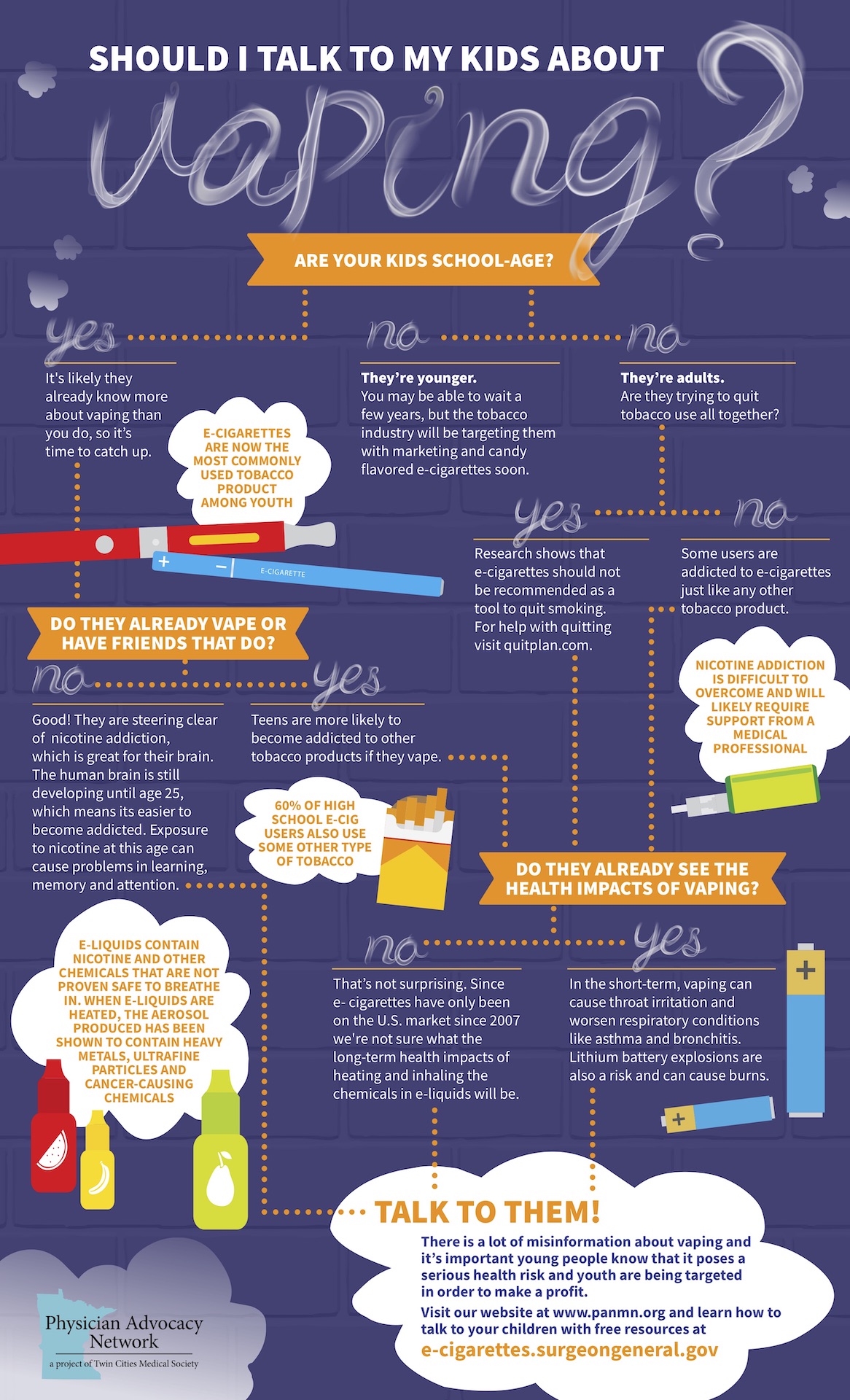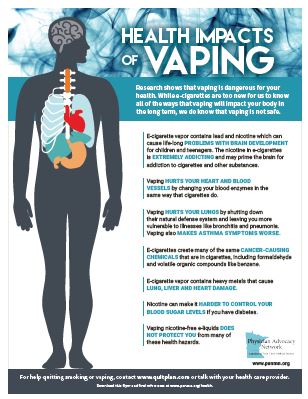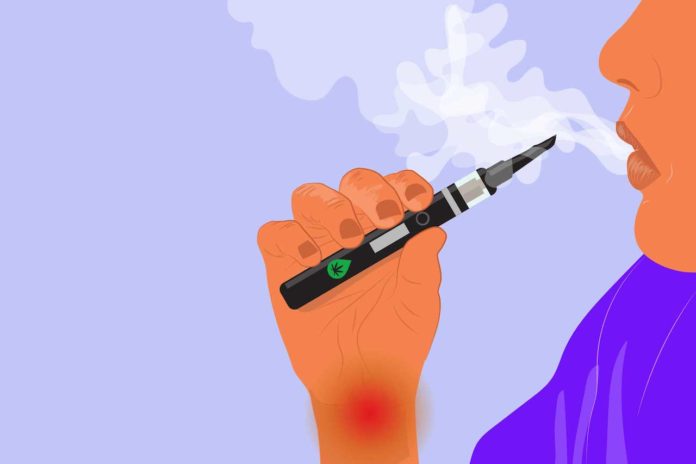Recently your newsfeed has probably been flooded with horror stories of vaping gone wrong — kids who turned to vaping as a presumably safer alternative to smoking cigarettes were ending up in the hospital, on a respirator, or worse, suffering the fatal consequences of their vice. In the past handful of months alone hundreds of people, mostly teens and young adults in their 20s, have ended up hospitalized for a mysterious respiratory disease that left them on ventilators, clutching to their lives. And the scariest part is that medical experts don’t know exactly why this is happening, but they have a suspicion that it is linked to vaping.
Though there is still a lot we don’t know, it’s becoming increasingly clear that this life-threatening illness linked to vaping is not just a series of fluke incidences but rather an epidemic. It’s starting to seem like vaping (and all of the deadly health risks that come along with it) is the equivalent of the cigarette epidemic for a new generation. Several decades ago (and long before that) people were smoking cigarettes without a care in the world, blissfully unaware of the damage they were doing to their bodies. Today, people, particularly younger people, have turned to vaping and e-cigarettes as a “safer” alternative to smoking, and we’re slowly learning that the consequences of that assumption can be dangerous and do damage of epic proportions. Sorry to be the bearers of bad news, but vaping is not as innocuous as you thought, and you might want to think twice before you grab that pen or vaping device.
Arguably, the most terrifying and frustrating part about the whole vaping debate is that there is still so much we don’t know. We don’t know why there have been hundreds of cases of respiratory illnesses possibly related to vaping, we don’t know exactly what was being inhaled by those patients and we don’t know what the connection is or the common thread between those cases. What we do know is that most of these patients were young — in their teens and 20s — and were otherwise in perfect health, prior to their mysterious respiratory illness. Most of them presented with severe shortness of breath, extended periods of vomiting, fever and fatigue. Some of them ended up in the ICU or on a ventilator. And because many of those people either denied vaping or were completely ignorant to what they inhaled (and where they bought it), it’s been a tragically challenging disease to treat and cure, according to a recent report by the NY Times.
But as with so many other preventable illnesses, knowledge is power, and we all need to get as educated as possible to protect our health.
So let’s unpack all the facts — the good, the bad, the confusing and scary truths about vaping, and we’ll let the experts decide whether it’s really safe to vape anything.
What Exactly is Vaping?
First and foremost, we need to understand what it really means to vape. It’s a term that’s thrown around often without people really knowing what it is, or what is considering vaping. Vaping can refer to a couple of different substances, but the process and devices are the same. To vape is to inhale an aerosol containing nicotine or other substances. You vape from devices that are known collectively as ENDS (electronic nicotine delivery systems). These can come in the form of electronic cigarettes, or e-cigarettes, e-pens, e-pipes or e-hookahs. Sometimes these ENDS look like USB drives, sometimes they look like actual cigarettes, and sometimes they look like pens. They are often battery powered, and they use a heating element to heat liquid from a refillable cartridge, releasing a chemical-filled aerosol that you then inhale.

In terms of substances, you can vape nicotine, which is what most vapes or pens contain, including the most popular brand of e-cigarettes, JUULs. You can also vape marijuana with a pen that contains THC oil that is heated up and turned into a chemical aerosol that you inhale.
For e-cigarettes, the main component is an e-liquid that is created by extracting nicotine from tobacco and mixing it with a base as well as other chemicals, which have been shown to cause lung damage. Unfortunately, the chemicals in these pens can still do a lot of irreversible damage to your lungs and your body, but because you’re not actually inhaling smoke as you might with traditional cigarettes, people don’t acknowledge the risk, or don’t associate the severity of the potential health issues with vaping.
Vaping is On The Rise, Reaching Record Levels of Use Especially Among Young Adults and Teens
While e-cigarettes have been around in the US for nearly a decade, they have recently become more popular than ever, especially among younger generations who are drawn to the cool, sleek, modern appearance of the vaping devices. In 2015 the U.S. surgeon general reported that e-cigarette use among high school students had increased by 900 percent, and 40 percent of those young e-cigarette users had never smoked regular tobacco. These statistics started to dispel the previously held assumption that e-cigarettes were mostly used by adults who were trying to quit smoking and who were turning to vaping as an alternative and a gradual way to kick their habit. More recently, in 2018, vaping continued to explode among American teenagers who had never smoked before.

Really good marketing may be partially to blame, but more than that, it is believed that many teens and young adults wrongfully assume that vaping is less harmful than smoking. In addition, vape cartridges can be formulated with fruity and appealing flavorings such as apple pie or watermelon, making them more enticing to younger users.
Regardless of why vaping is on the rise among young people, the fact remains that more and more teens and young adults are using these devices regularly, and reports are showing that they are paying the ultimate price.
As of September, the number of cases of severe lung illness linked to vaping more than doubled to 450 possible cases in 33 states across the country. And the number of deaths related to vaping rose to five.
This drastic rise in vaping-related respiratory disease and death has lead medical experts and federal health officials to warn the public about the dangers of vaping and to discourage the use of vaping devices. “There is clearly an epidemic that begs for an urgent response,” said Dr. David C. Christiani of the Harvard T.H. Chan School of Public Health in an article for The New England Journal of Medicine.
The Risks of Vaping on Your Lungs and Your Brain
So why exactly is vaping so bad for you? Is it due to the nicotine in the same way that smoking cigarettes can negatively affect your lungs and heart? Or is there a bigger risk at play?
Yes, and yes.
While we still don’t know exactly what it is about vaping that can wreak such havoc on your lungs and your body, experts are pointing fingers at a few key factors.
First of all, most e-cigarettes contain nicotine, the same addictive drug contained in regular cigarettes and other tobacco products. Many people falsely assume that if they’re not inhaling smoke, they’re not putting their lungs at risk. But that’s completely inaccurate. In fact, a recent CDC study found that 99% of the e-cigarettes sold in assessed venues in the United States contained nicotine, even some products that did not disclose nicotine contents on their marketing materials. And the JUUL brand in particular contains incredibly high levels of nicotine — according to the manufacturer a single JUUL pod contains as much nicotine as a pack of 20 regular cigarettes.
We know that nicotine can be extremely harmful to both the lungs and the developing adolescent brain. Nicotine use in adolescence can harm the parts of the brain that control attention, learning, mood, and impulse control. And on top of that, nicotine is also an addictive substance, whether it is inhaled via smoke or vape. According to Michael Blaha, M.D., M.P.H., director of clinical research at the Johns Hopkins Ciccarone Center for the Prevention of Heart Disease, nicotine is a toxic substance that can raise your blood pressure and increase your risk of heart attack. “People need to understand that e-cigarettes are potentially dangerous to your health; you’re exposing yourself to all kinds of chemicals that we don’t yet understand and that are probably not safe,” said Blaha.
Vaping THC May be Linked to a Mysterious Lung Disease that has Caused Death and Illness for Hundreds
As if the risks of vaping nicotine weren’t damaging enough, there are risks vaping marijuana as well, and all of these risks combined may be linked to the mysterious lung disease that has killed five people to date, and has sent hundreds to the hospital with severe respiratory impairment.
According to the report published in The New England Journal of Medicine, 84 percent of patients had vaped a product including THC, the high-inducing chemical in marijuana. The CDC and the Food and Drug Administration (FDA) have not found a single device, product or substance that is linked to all cases of lung disease, but they did note that many sick individuals vaped THC before developing their illness, either instead of or in addition to nicotine.
Some doctors have suggested that when cannabinoid oils are vaporized in cartridges they may be causing some of the lung inflammation. Other reports indicate that the actual processing of the THC is what is causing the risk to your lungs, not the chemical compound itself. According to Jacob Borodovsky, an epidemiologist at Washington University School of Medicine in St. Louis, “if I had to bet money on whether or not THC is causing these lung-related issues, I wouldn’t put it on the THC compound itself. I would put it on the way in which the THC is prepared and delivered.”
That’s because, in order to produce vape pen liquid the THC must first be suspended in an oil solution that often also includes other chemicals. Those chemicals are somewhat unknown, and unregulated. Recently New York state health officials have pointed to vitamin E acetate, an unauthorized additive in some marijuana vape pods, as a potential cause of the vape-related lung disease. But none of the current information is 100 percent conclusive. Another potential causes might be related to the heating coils in vaping devices, which potentially release metal particles that could be inhaled and cause lung damage. Because these deaths and cases of illness have been linked to a range of products and devices, not one single brand, substance or type of vaping product, it’s a cause for concern for anyone who previously thought that vaping was a safer way to consume marijuana.
The Key Takeaway: Vape With Caution
So what’s the bottom line? Is it safe to vape anything? Or is all vaping bad?

The unfortunate answer is that we still don’t know the answer with complete certainty. There are still several unknown factors in terms of what is actually causing this lung disease, what aspect of vaping poses the greatest risk to your health, and is it a matter of quantity or quality or both. We don’t know if these cases of illness are connected to specific types of devices, specific substances, or dangerous methods of preparing those chemicals.
But based on what we do know, and what experts are investigating, it seems like the safer plan of action would be to minimize vaping, and to be extremely cautious about what you inhale, especially vape products. The CDC is stressing that you should never buy cannabis and other e-cigarette products off the street, and be careful not to consume bootleg products because of the increased health risks. The report is pretty clear: Regardless of the ongoing investigation, e-cigarette products should not be used by youth, young adults, pregnant women, as well as adults who do not currently use tobacco products. If you use e-cigarette products, monitor yourself for symptoms (e.g., cough, shortness of breath, chest pain) and promptly seek medical attention if you have concerns about your health. CDC and FDA will continue to advise and alert the public as more information becomes available.
For Image credit or remove please email for immediate removal - info@belatina.com



































